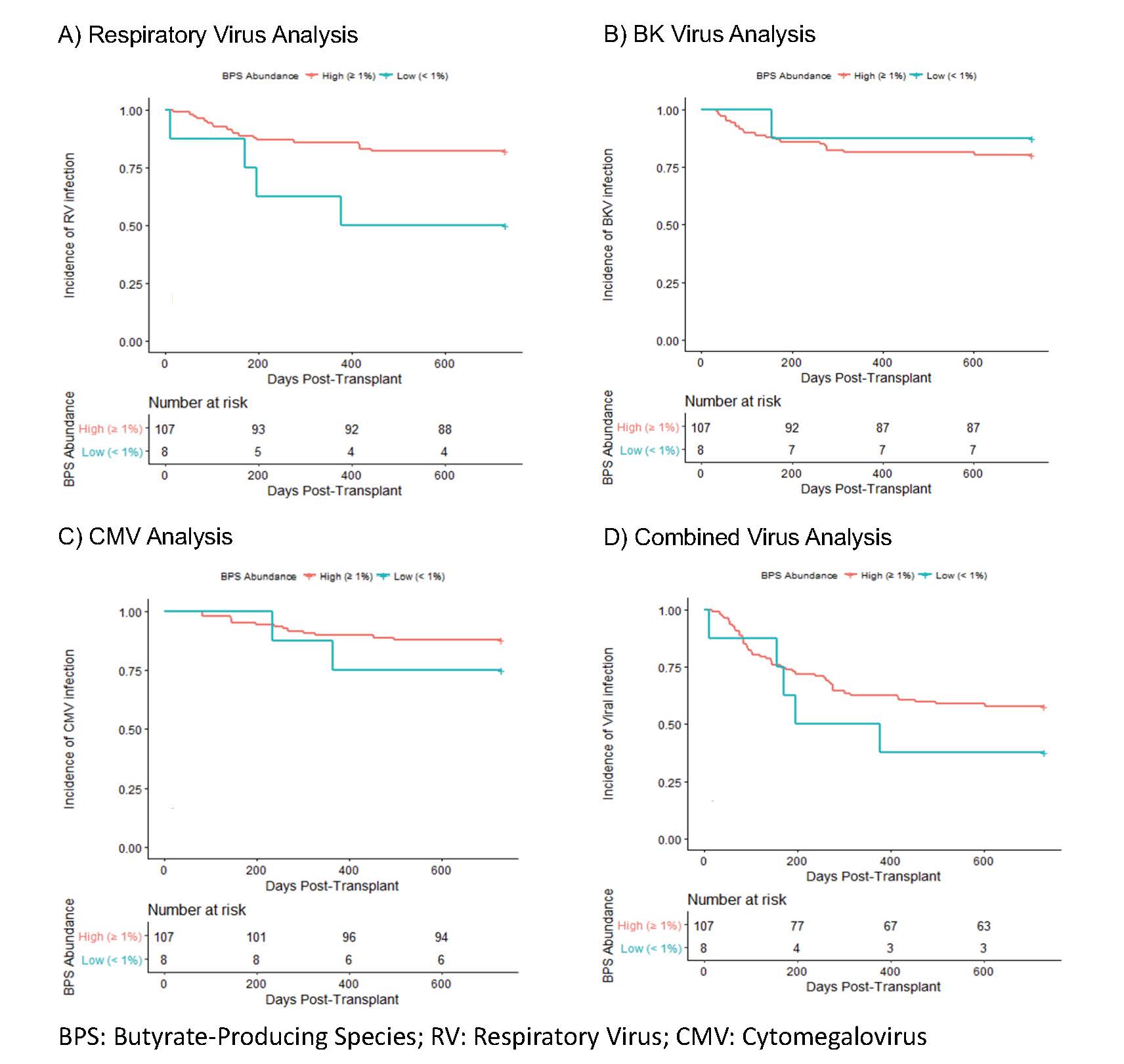Butyrate-Producing Gut Bacteria and Future Development of Viral Infections in Kidney Transplant Recipients
1Weill Cornell Medicine, New York, NY, 2Memorial Sloan Kettering Cancer Center, New York, NY
Meeting: 2019 American Transplant Congress
Abstract number: 203
Keywords: Infection
Session Information
Session Time: 8:30am-9:15am
 Presentation Time: 9:00am-9:15am
Presentation Time: 9:00am-9:15am
Location: Veterans Auditorium
*Purpose: Recent studies suggest that the gut microbiome plays a critical role in protecting its host from infections beyond Clostridium difficile. Notably, butyrate-producing bacteria may be beneficial to gut health and have recently have been associated with lower rates of respiratory tract infections in bone marrow transplant recipients (Haak et al., Blood 131(26): 2978, 2018). In this study, we evaluated the relationship between butyrate-producing gut bacteria and future development of viral infections in kidney transplant recipients.
*Methods: We evaluated stool samples collected two weeks after transplantation from 115 kidney transplant recipients and profiled the gut microbiome using 16S rRNA gene deep sequencing of the V4-V5 hypervariable region (Illumina Miseq, 250 base pair by 250 base pair). Based on a 1% relative abundance cutoff previously reported in Haak et al. 2018, we evaluated whether having a low abundance of butyrate-producers (<1% relative abundance) was a risk factor for development of three common viral infections within the first two years after kidney transplantation: BK viremia, cytomegalovirus (CMV) viremia, and respiratory tract (RV) infections.
*Results: In the study cohort, 23 developed RV infections, 22 developed BK viremia, 15 developed CMV viremia, and 50 developed at least one of the three viral infections. Univariate Cox regression analysis showed that subjects with low abundance of butyrate-producers had a significantly increased risk for developing RV infections than those with high abundance of butyrate-producers (Hazard Ratio: 3.1, P=0.03) (Survival Curve Analysis, Fig. A). There was no significant difference in the development of BK viremia (P= 0.62) (Fig. B), CMV viremia (P=0.32) (Fig. C), or a combination of the three viral infections (P=0.28) (Fig. D) between subjects who had high vs. low abundance butyrate-producers.
*Conclusions: Our results confirm and extend the novel association between the gut microbiome and development of viral infections from stem cell transplant recipients to solid organ graft recipients. Altogether, these findings support targeting the gut microbiota as a strategy to prevent and/or treat viral infections.
To cite this abstract in AMA style:
Lee J, Huang J, Magruder M, Zhang L, Lubetzky M, Dadhania D, Edusei E, Pamer E, Suthanthiran M. Butyrate-Producing Gut Bacteria and Future Development of Viral Infections in Kidney Transplant Recipients [abstract]. Am J Transplant. 2019; 19 (suppl 3). https://atcmeetingabstracts.com/abstract/butyrate-producing-gut-bacteria-and-future-development-of-viral-infections-in-kidney-transplant-recipients/. Accessed December 24, 2025.« Back to 2019 American Transplant Congress

